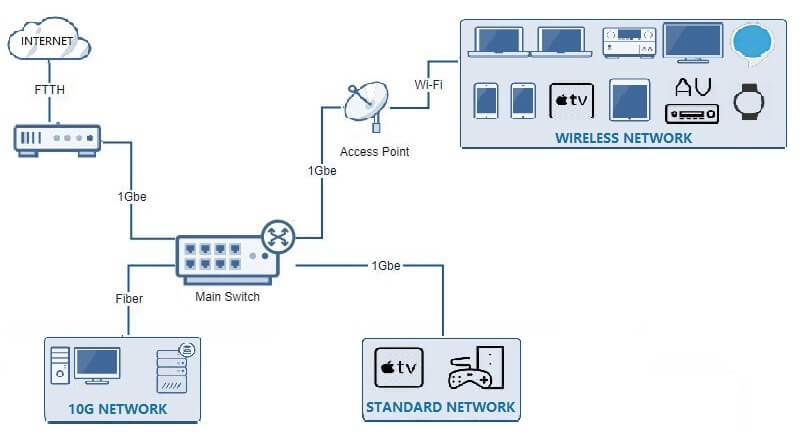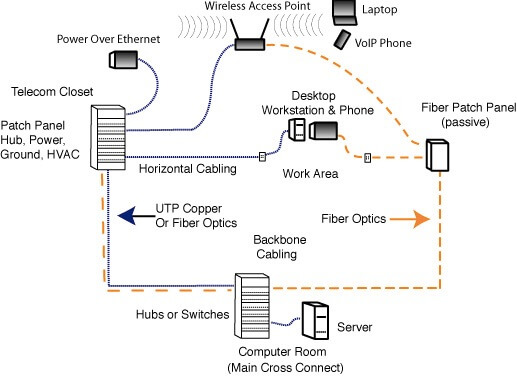Explore the fundamentals of fiber optic networking in this article. Discover the diverse range of fiber-optic components employed in residential, commercial, and inter-building setups. Uncover the applications of fiber optics in high-speed networking, electrical isolation, and expanding Ethernet networks.
Benefits of Fiber Optic Home Networking
Overcoming Distance Constraints: Leveraging Fiber Optics for Extended Cable Runs
Conventional copper Ethernet cables, like Cat 6a or Cat 8, are typically limited to a maximum length of 100 meters (328 feet). While this distance is substantial, there are instances when longer cable runs are essential. Here’s where fiber-optic cables come into play, offering significantly extended maximum lengths.
Fiber optics enable far-reaching connections. Transceivers with shorter ranges can achieve distances of up to 550 meters at 1 Gbps, while those with the longest ranges can span an impressive 160 kilometers (approximately 100 miles)!
The versatility of fiber-optic cable eliminates the constraints posed by copper Ethernet cables, providing the capacity for exceptionally lengthy cable runs. With options like fiber to Ethernet media converters or coaxial solutions, you can transcend the limitations of traditional copper Ethernet cables.
Enhanced Electrical Isolation Against Lightning, Surges, and Static
Traditional copper Ethernet and coax cables used for outdoor connections can expose your entire home or office network to potential hazards from lightning-induced power surges. A single lightning strike can surge through coax and copper Ethernet cables within your premises, causing irreparable damage to your computer and network equipment.
However, fiber-optic lines are impervious to the transmission of electricity from lightning, power surges, and static discharges. This intrinsic characteristic of fiber optics makes it an invaluable safeguard against these risks, providing a reliable form of insurance.
Fiber-to-Ethernet media converters bridge the gap between standard RJ-45 copper Ethernet cables and fiber-optic cables. Employing a pair of these converters establishes a protective electrical barrier, especially useful when extending Ethernet connections between buildings or linking to outdoor Power over Ethernet (PoE) devices like cameras and Wi-Fi access points. Moreover, fiber-optic networking introduces separation between devices through the use of fiber-optic cables, thereby preventing potential electrical interference.
Tailored High-Speed Networks: Unleashing Custom Connectivity
Leveraging switches and network adapters equipped with SFP modules unlocks the potential to establish custom high-speed Ethernet networks. A prime illustration of this lies in the utilization of QSFP+ fiber transceiver modules, which can facilitate impressive speeds of 40 Gbps within a building’s network infrastructure. In contrast, adhering to traditional copper cabling would inevitably curtail these speeds to shorter distances. The adaptability and enhanced performance offered by fiber optics make it possible to design and implement bespoke high-speed networks that align precisely with specific requirements, transcending the limitations imposed by conventional copper setups.
Fiber Optic Home Networking Components
Embarking on the journey to establish a fiber network entails the integration of several key components. Among the most widely utilized devices in a home fiber network are the fiber optic cable, transceiver, media converter, home network switch, home router, and more. These elements collectively form the foundation of a robust and efficient fiber network infrastructure, enabling seamless connectivity and high-speed data transmission for your home environment.
Fiber Optic Cable
Fiber optic cable, a slender and transparent tube composed of silica, serves as a conduit for guiding light waves to transport data. Available in diverse grades, these cables exhibit varying levels of attenuation and the maximum distance they can effectively transmit signals.
Within the realm of multi-mode fiber, cable grades encompass OM1, OM2, OM3, and OM4. Among these, OM3 and OM4 stand out as optimal selections when financial considerations permit.
In the domain of single-mode fiber, cable grades encompass OS1 and OS2. OS1 is particularly well suited for indoor applications, while OS2 shines in outdoor scenarios.
Fiber to Fiber Media Converters
Fiber-to-fiber media converters play a pivotal role in seamlessly converting signals between different fiber types. This includes the conversion between single-mode fiber (SMF) and multi-mode fiber (MMF), as well as the transformation between single fiber and dual fiber cable configurations.
Fiber to Ethernet Media Converter
A fiber media converter, alternatively referred to as a fiber to Ethernet converter, serves as a pivotal tool in bridging the gap between distinct networking mediums. This versatile device facilitates the conversion between conventional copper Ethernet cable, such as Cat 6a, and fiber-optic connections, seamlessly facilitating bidirectional data transmission.
The primary application of a fiber media converter revolves around two key scenarios: extending transmission distances beyond the limits of copper cabling and strategically segmenting networks to enhance resilience against potential electrical surges.
Through this adaptable technology, network administrators can achieve extended reach and enhanced protection, ushering in a new realm of connectivity possibilities.
Fiber Switches
The fiber-optic switch stands as a pivotal enabler, facilitating the seamless connection of two or more fiber-optic cables to create a robust network infrastructure. Its operation parallels that of a conventional Ethernet switch, enhancing the versatility of fiber-optic networks. By harnessing the capabilities of a fiber switch in conjunction with a fiber network adapter, the potential emerges to establish direct fiber connectivity for desktop computers or servers.
Fiber Network Adapter
The fiber network adapter introduces a unique capability – establishing a direct link between fiber and your desktop computer or server. In this setup, considering the integration of a fiber switch could prove beneficial. By incorporating a fiber-optic cable between the fiber-optic network adapter and the fiber-optic switch, you ensure an equivalent level of electrical isolation as achieved through a fiber media converter.
This advancement enables high-speed fiber connections directly to your computer, bypassing the need for conversion to copper Ethernet cable. The approach, known as fiber-to-the-desktop (FTTD), entails running a fiber connection to your computer. This not only facilitates efficient connectivity but also showcases the potential synergy between fiber network adapters and switches in optimizing network performance and reliability.
Fiber Optical Transceiver
An optical transceiver, a versatile device, facilitates the conversion of electrical signals into optical signals and vice versa. This seamless transformation is a hallmark of efficient fiber network operations. These transceivers are integral components, often found in various form factors across fiber network devices, accommodating a diverse array of speeds and applications.
Among these, the small form-factor pluggable (SFP) transceivers emerge as versatile, compact, and hot-pluggable network interface modules. Designed to accommodate both fiber and copper Ethernet cables, SFP modules empower the transformation between cable types when integrated within a switch.
While SFP modules can sometimes be compatible with SFP+ slots, it’s important to note that specific form factor matches are usually required for other combinations.
The following are common form factors for fiber Ethernet transceivers and their supported max speeds.
| Form Factor | Supported Speeds | Supported Media Type |
| SFP | 100 Mbps or 1 Gbps | Fiber or Copper |
| SFP | 2.5 Gbps or 5 Gbps | Copper |
| SFP+ | 10 Gbps | Fiber or Copper |
| SFP28 | 25 Gbps | Fiber or DAC |
| SFP 56 | 50 Gbps | Fiber or DAC |
| QSFP | 4 Gbps | Fiber or DAC |
| QSFP+ | 40 Gbps | Fiber or DAC |
| QSFP28 | 50 or 100 Gbps | Fiber or DAC |
| QSFP56 | 200 Gbps | Fiber or DAC |
| QSFP-DD | 400 Gbps | Fiber or DAC |
FAQs about Fiber Optic Home Networking
Q: Is fiber optic Internet faster than cable?
A: Absolutely, fiber optics can transmit data at speeds up to 100 times faster than traditional copper cables.
Q: Is fiber optic installation expensive?
A: Although the initial cost might be slightly higher than traditional copper cabling, fiber optics offer substantial long-term benefits and savings.
Q: Are fiber optic cables durable?
A: Indeed, fiber optic cables are resistant to electromagnetic interference and boast a longer lifespan compared to traditional cables.
Q: Can I install fiber optic cables myself?
A: While some homeowners may choose to self-install fiber optics, it’s recommended to hire a professional for a successful installation.
Q: How can I self-install a home fiber network?
A: Follow these basic steps for self-installing fiber internet.
- Locate your fiber network terminal.
- Connect the fiber terminal to the network box.
- Plug in your network box.
- Connect your device to the network box.
- Set up your home Wi-Fi network.
Q: Does fiber optic increase home value?
A: Absolutely, a home equipped with a fiber optic structured wiring system can command a higher price in the real estate market.
Conclusion
Deploying a home fiber network is simpler and more budget-friendly than you might think. With a comprehensive house network assessment and strategic selection of affordable home network devices, you can create a high-bandwidth, low-latency fiber optic network.
Upgrade your home network now for improved performance. Enjoy seamless web browsing, smooth streaming of movies and TV shows, online gaming, and more.





